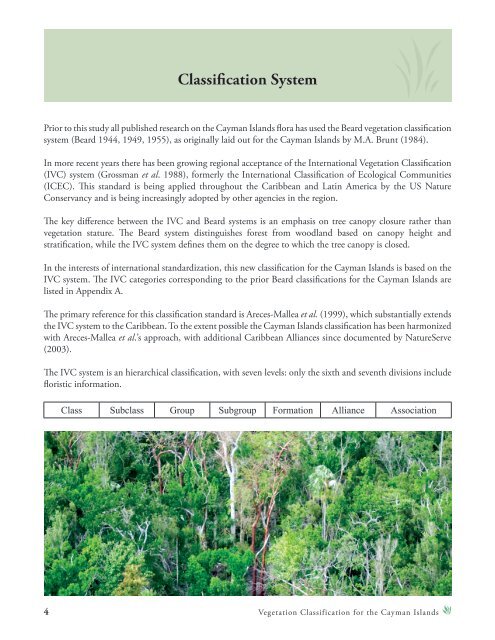Vegetation Classification for the Cayman Islands
Vegetation Classification for the Cayman Islands
Vegetation Classification for the Cayman Islands
You also want an ePaper? Increase the reach of your titles
YUMPU automatically turns print PDFs into web optimized ePapers that Google loves.
<strong>Classification</strong> System<br />
Prior to this study all published research on <strong>the</strong> <strong>Cayman</strong> <strong>Islands</strong> flora has used <strong>the</strong> Beard vegetation classification<br />
system (Beard 1944, 1949, 1955), as originally laid out <strong>for</strong> <strong>the</strong> <strong>Cayman</strong> <strong>Islands</strong> by M.A. Brunt (1984).<br />
In more recent years <strong>the</strong>re has been growing regional acceptance of <strong>the</strong> International <strong>Vegetation</strong> <strong>Classification</strong><br />
(IVC) system (Grossman et al. 1988), <strong>for</strong>merly <strong>the</strong> International <strong>Classification</strong> of Ecological Communities<br />
(ICEC). This standard is being applied throughout <strong>the</strong> Caribbean and Latin America by <strong>the</strong> US Nature<br />
Conservancy and is being increasingly adopted by o<strong>the</strong>r agencies in <strong>the</strong> region.<br />
The key difference between <strong>the</strong> IVC and Beard systems is an emphasis on tree canopy closure ra<strong>the</strong>r than<br />
vegetation stature. The Beard system distinguishes <strong>for</strong>est from woodland based on canopy height and<br />
stratification, while <strong>the</strong> IVC system defines <strong>the</strong>m on <strong>the</strong> degree to which <strong>the</strong> tree canopy is closed.<br />
In <strong>the</strong> interests of international standardization, this new classification <strong>for</strong> <strong>the</strong> <strong>Cayman</strong> <strong>Islands</strong> is based on <strong>the</strong><br />
IVC system. The IVC categories corresponding to <strong>the</strong> prior Beard classifications <strong>for</strong> <strong>the</strong> <strong>Cayman</strong> <strong>Islands</strong> are<br />
listed in Appendix A.<br />
The primary reference <strong>for</strong> this classification standard is Areces-Mallea et al. (1999), which substantially extends<br />
<strong>the</strong> IVC system to <strong>the</strong> Caribbean. To <strong>the</strong> extent possible <strong>the</strong> <strong>Cayman</strong> <strong>Islands</strong> classification has been harmonized<br />
with Areces-Mallea et al.’s approach, with additional Caribbean Alliances since documented by NatureServe<br />
(2003).<br />
The IVC system is an hierarchical classification, with seven levels: only <strong>the</strong> sixth and seventh divisions include<br />
floristic in<strong>for</strong>mation.<br />
Class Subclass Group Subgroup Formation Alliance Association<br />
<strong>Vegetation</strong> <strong>Classification</strong> <strong>for</strong> <strong>the</strong> <strong>Cayman</strong> <strong>Islands</strong>


